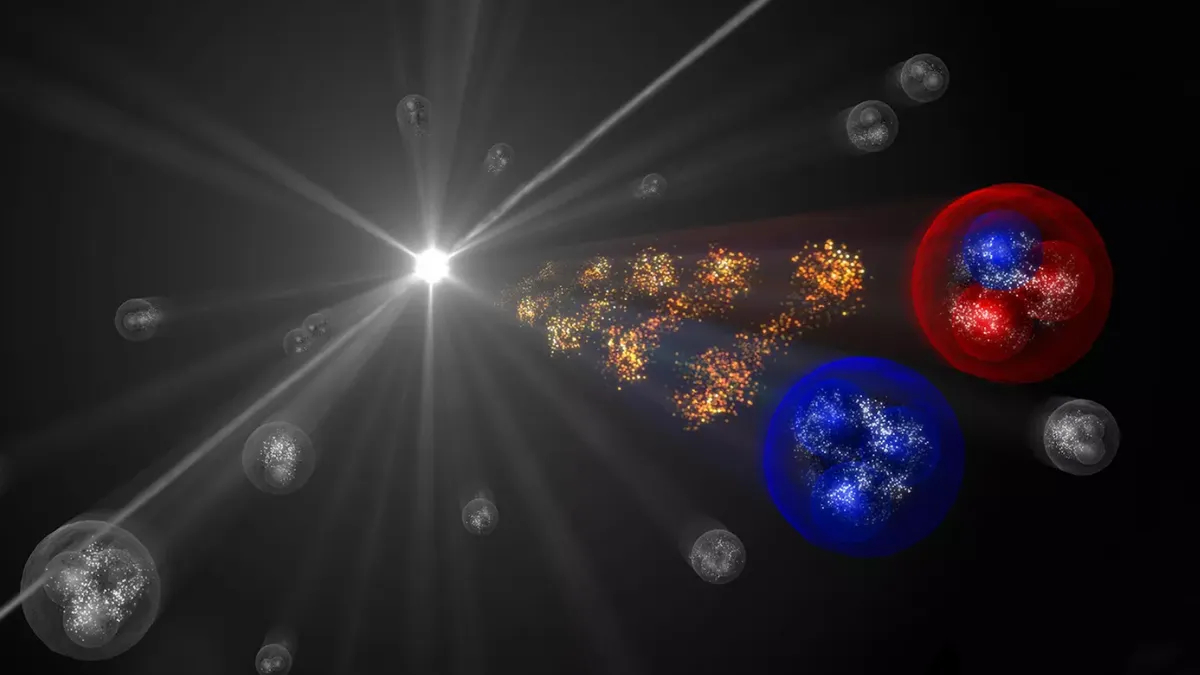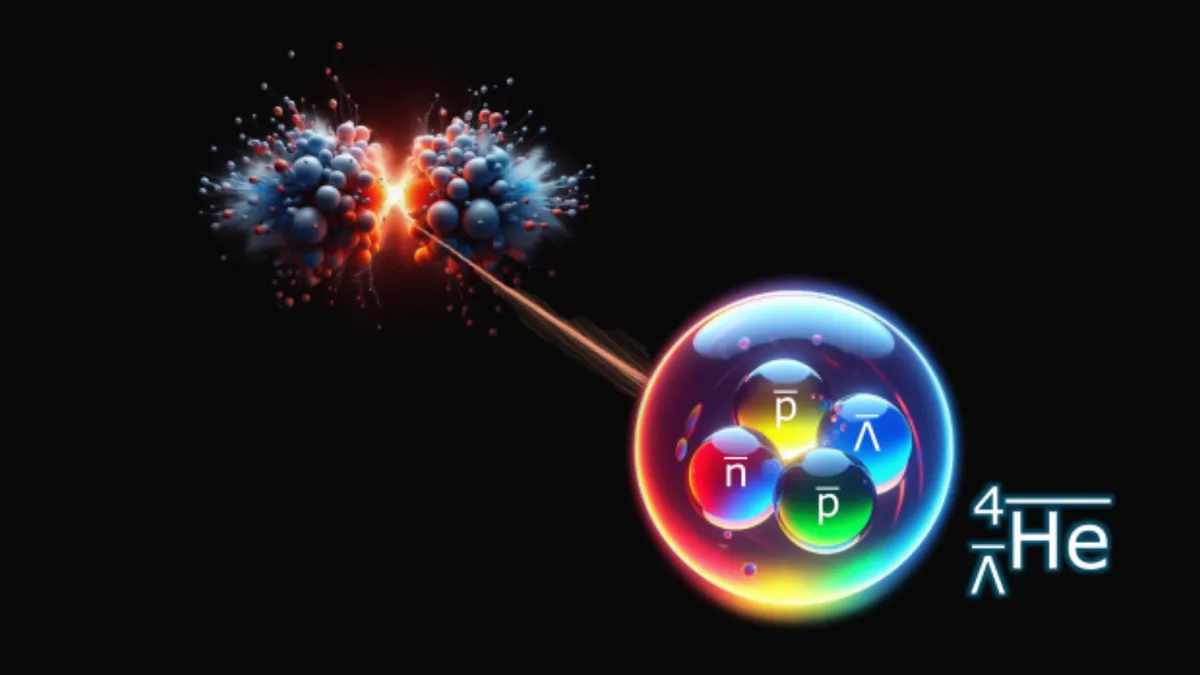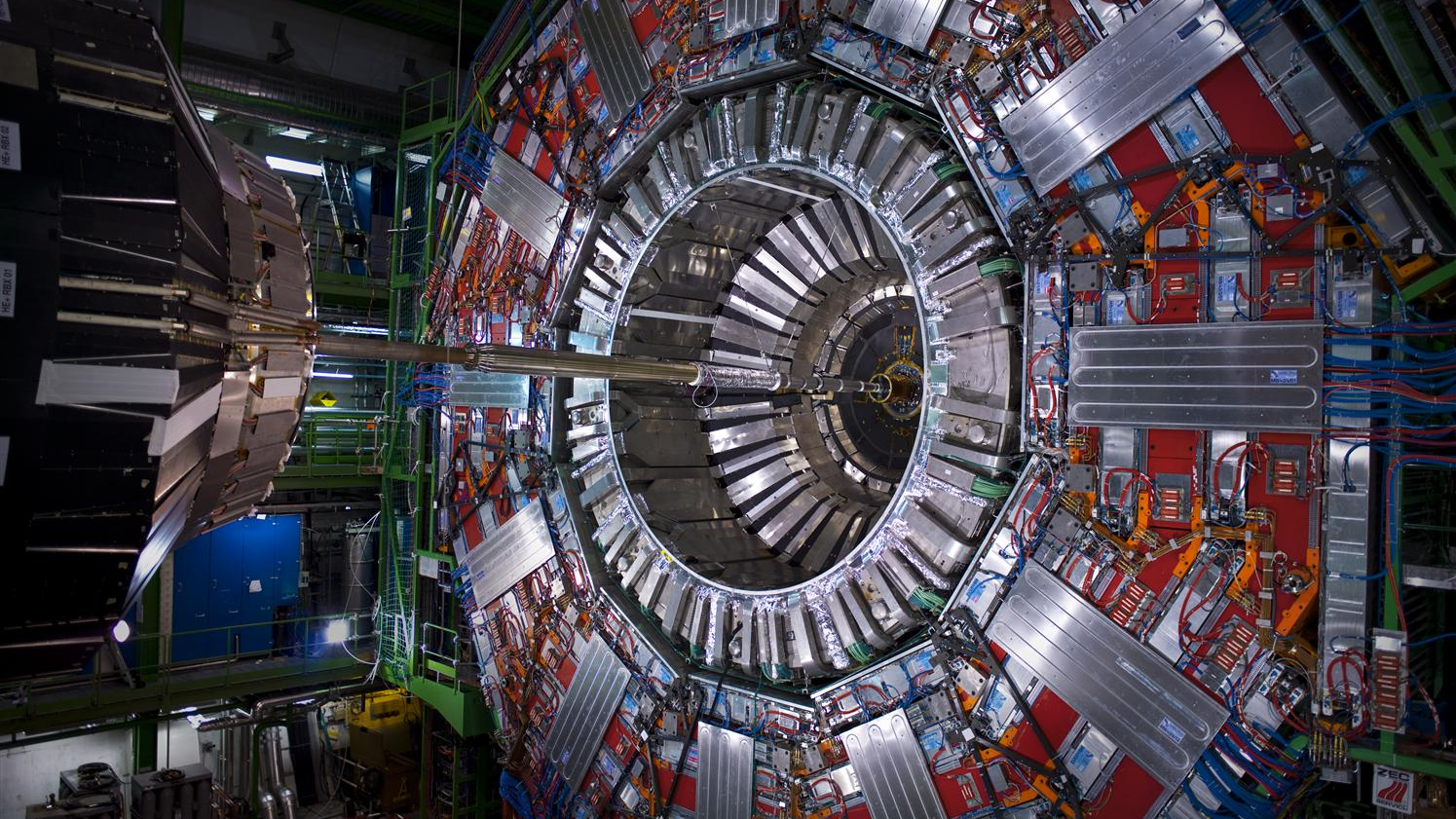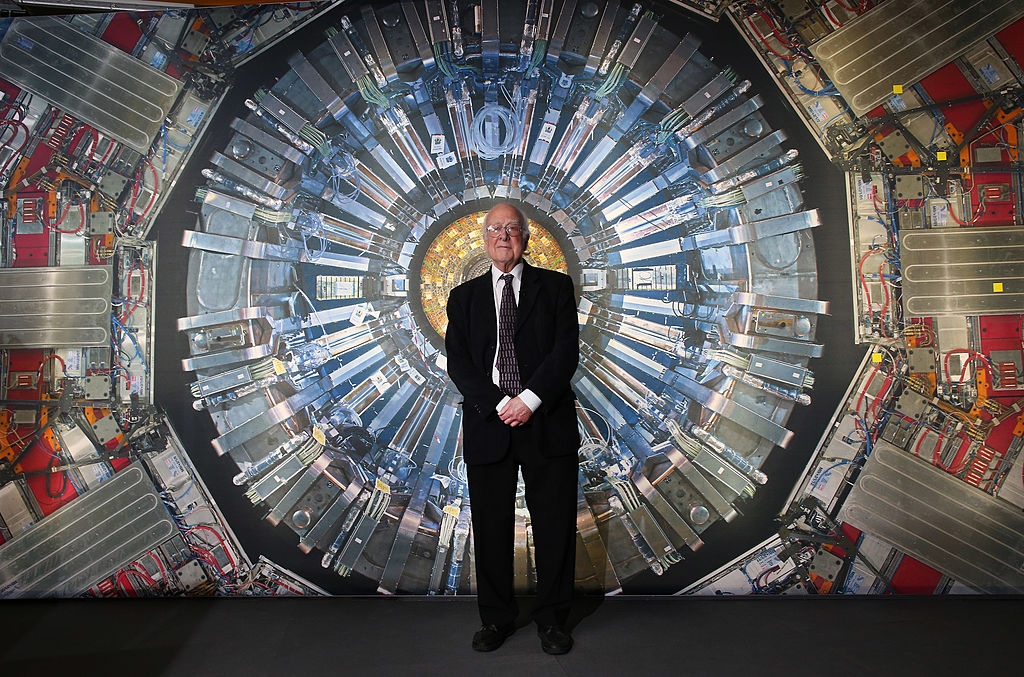
Everything in the universe is, quite literally, built upon particles, ranging from the fundamental particles that construct atoms that make up everything we see around us to the exotic ones that give rise to elusive phenomena like antimatter and dark matter. The former help us observe and manipulate our world while the latter help us understand it, hinting at profound mysteries surrounding the universe’s creation, evolution and structure.
When it comes to particle physics, however, much of the action takes place in giant accelerators smashing particles together at the speed of light. These accelerators are sometimes humanmade and therefore live on Earth — other times, they're of the cosmic sort and exist in deep space.
Indeed, over the past 12 months there has been a great deal of exciting particle action on Earth and in space — and we begin our round-up of 2024's particle physics stories with news that sounds more like science fiction.
The year we learned to move antimatter
No material is more volatile than antimatter, which is made of particles of equal mass but opposite charge to normal matter, so things like anti-protons and positrons, which are the antimatter version of electrons. Place a particle of antimatter with a particle of normal matter and they annihilate each other, instantly, in a burst of energy.
In science fiction, antimatter is typically written as an unrivaled power source, driving starships and detonating as bombs. In science fact, just being able to move antimatter without it coming into contact with normal matter and annihilating has proven to be a challenge, but scientists at CERN think they have now finally figured out a way to do that, and what's more, they're putting it to the test.
A report in Nature, published on Nov. 26, 2024, described how two teams of researchers are competing to be the first to move antimatter, hoping to initially transport antiprotons across CERN as a proof of concept before eventually taking the particles hundreds of miles away to a dedicated laboratory at the Heinrich Heine University in Dusseldorf, where its enigmatic properties can be examined more closely. To move the antimatter, the teams built containers that generate electromagnetic fields from superconducting magnets to hold the antimatter in place, and in a vacuum, without it touching anything.
Antimatter is both scarce and expensive to make, and it cannot simply be made on tap. While there is antimatter in space — as we shall see, it pays us a visit in cosmic rays — on Earth, scientists have only been able to produce about 20 billionths of a gram worth of antimatter. It would cost trillions to make just one gram. So, sharing around what few antimatter particles we can make at CERN's Large Hadron Collider (LHC) is the next best thing.
All in all, we might not be ready to build antimatter-powered spacecraft anytime soon, but transporting it will enable physicists to dig into antimatter's secrets, including why there is so little of it in the universe.
The year we broke the heaviest antimatter-particle record — twice!
Most antimatter particles created in particle accelerators have been fairly simple: anti-protons, positrons, anti-tritium and anti-helium — that sort of thing. However, in experiments at the Relativistic Heavy Ion Collider (RHIC) in New York and at the Large Hadron Collider, scientists have this year succeeded in creating "hyper" particles of antimatter.
The "hyper" is short for hyperon. Consider a particle such as a proton, which is made from three even smaller particles called quarks. A proton has two "up" quarks and one "down" quark (these names are just to differentiate between different types of quark; there's nothing really up or down about them). Conversely, a neutron is made from one up quark and two down quarks. By comparison, hyperons feature a kind of quark called a "strange" quark alongside the up and down ones. When hyperons are incorporated into regular atomic nuclei, those nuclei are made heavier than their regular counterparts. In addition, there are also antimatter versions.
Earlier this year, researchers were able to produce anti-hyperhydrogen-4, which contains an anti-proton, two anti-neutrons and an anti-hyperon, at RHIC. Then, a few months later, an even heavier antiparticle — anti-hyperhelium-4 that is made from two anti-protons, an anti-neutron and an anti-hyperon — was detected by the ALICE (A Large Ion Collider Experiment) instrument at the LHC. Anti-hyperhydrogen-4 and anti-hyperhelium-4 are the most massive anti-particles ever created in a laboratory.
Physicists found that the heavy particle collisions at RHIC and the LHC that formed these anti-hyperparticles created equal amounts of matter and antimatter. That might sound unsurprising — until we look around the universe and see a cosmos filled with normal matter and barely any antimatter. Why the universe made more matter than antimatter in the Big Bang is a mystery — if the two are perfectly symmetrical, then shouldn't there be an equal amount of both? Nonetheless, this asymmetry appears to be a good thing. If you recall, equal amounts of normal matter and antimatter would have completely annihilated one another, leaving the universe filled with nothing but photons of energy released by the annihilation.
That would mean there would be no stars, no planets, and no life.
By producing equal amounts of matter and antimatter, the experiments at RHIC and the LHC have simply deepened the mystery of the matter–antimatter asymmetry in the universe and why the Big Bang favored matter over antimatter. Still, we're slowly getting closer to the truth.

The year we connected antimatter to dark matter?
As we've already mentioned, antimatter isn't only generated in particle accelerators on Earth, but also comes from energetic processes in space that fling charged particles of matter and antimatter at us in the form of cosmic rays. These are particles moving at almost the speed of light and are thought to be produced by some of the most violent and magnetic objects in the universe: supernova remnants, active black holes and so forth.
Because of the observed asymmetry between matter and antimatter, most of these cosmic rays are made from matter, but some are formed of antimatter. The trouble is, we've been detecting more antimatter cosmic rays than we can easily explain.
On board the International Space Station is an experiment called the Alpha Magnetic Spectrometer, or AMS-02, which detects cosmic rays. AMS-02 has been detecting surprising amounts of antimatter in these cosmic rays, with significant abundances of anti-hydrogen-2, anti-helium-3 and anti-helium-4 having been detected by the AMS-02.
A new explanation proposed in 2024 is that these anti-particles are being produced by dark matter.
Nobody knows what dark matter is made from. All we know is that it is an invisible material that constitutes 85% of all the matter in the universe. The only way we know it is there is through its gravity.
Some models of dark matter predict that it could be made from a type of particle called a WIMP, or Weakly Interacting Massive Particle. Occasionally, a WIMP might interact with another WIMP, particularly near the Milky Way's heart, or the Galactic Center, where the density of dark matter is at its greatest. If that interaction takes place, the WIMPs could annihilate each other, producing a shower of other particles in the process — including antimatter.
The amount of anti-hydrogen-2 detected by the AMS-02 matches what models predict should result from WIMP annihilation. However, the observed abundances of anti-helium-3 and -4 in the cosmic rays are so great that they are much harder to explain. It may mean that our models that describe how WIMPs interact are wrong or incomplete, or possibly that WIMPs don’t exist at all – but then where is the antimatter coming from? As we come to the end of 2024, it is a puzzle that still hasn’t been solved.
The year crashing galaxy clusters revealed the motion of dark matter
One of the best places to measure possible dark matter interactions are galaxy clusters. A galaxy cluster contains vast amounts of dark matter, hot gas and assorted galaxies, all wrapped up in a gravitationally bound volume millions of light-years across. When two galaxy clusters collide, the clash is suitably titanic, and research from earlier this year gave us our most detailed look yet at such a collision.
During the collision, the galaxies mostly sailed through, the distances between them generally too great for there to be any crashes. The huge clouds of gas that fill each cluster, however, manage to smash together, emitting X-rays because they are so hot. Because the clouds of gas impede each other, they also don't travel very far in the collision.
In other words, we know where hot gas is coming from by detecting the X-rays, and we can see where the galaxies are just by looking. As for the dark matter, we can infer where it is by looking at how its gravity warps space, thereby creating gravitational lenses.
If dark matter does not interact at all, then it should exist alongside the galaxies in the collision having cleanly sailed through; if it interacts by a significant amount, we’d expect to see it closer to the hot gas. And if it interacts just a little bit, it would be around mid-way between the galaxies and the gas.
The problem is, we only see snapshots of these collisions between galaxy clusters. The collisions take place over hundreds of millions of years — so, we can't see the clusters moving, and we only see each collision from one angle that might not be the best angle. Discerning where the three components are in relation to each other in a collision is thus harder than it might seem.
Astronomers have witnessed many galaxy cluster collisions, the most famous being the Bullet Cluster. We saw the Bullet Cluster from a side-on vantage point, which makes it tricky to measure the motions of the components because we need to measure their Doppler shift, which requires a head-on alignment.
In 2024, that's what astronomers were able to do, with the galaxy cluster collision known as MACS J0018.5+1626, located 5 billion light-years away. Astronomers discovered that the dark matter had indeed decoupled from the hot colliding gas, and that it was moving at 10.8 million kilometers (6.7 million miles) per hour, which is about 1% of the speed of light. The findings suggest there’s not much interaction going on between the dark matter particles in the cluster and any other particle, although the measurements are not precise enough to tell whether there is a small amount of interaction or not.
This ambiguity still leaves the door open to many possibilities for the identity of dark matter.
The year we began waiting for a supernova to reveal the truth about dark matter
WIMPs have been the leading candidate for dark matter for years, but they're beginning to fall out of favor a little bit, since experiments have failed to detect them. A new competitor has risen to challenge WIMPs in the form of a hypothetical particle called the axion.
There's good reason to believe axions could be real. They're predicted by the theory of quantum chromodynamics, which concerns how the strong force binds quarks together to form protons and neutrons (and hyperons). It also just so happens that axions are a good candidate for dark matter. Yet, unfortunately nobody has ever detected an axion.
In 2024, scientists revealed a way that we could make that detection possible, but it requires a degree of luck and perfect timing.
According to the new research, the collapse of a massive star's core as it reaches the end of its life and turns into a neutron star during a supernova explosion could create axions aplenty in the first 10 seconds of that explosion. Unlike WIMPS, axions are not selective about how they interact, and a strong electromagnetic field, like the intense magnetic field of a massive dying star, could convert the axions into gamma-ray photons that we could then detect.
This is fine in principle, but challenging in reality, say the researchers. For one thing, the gamma rays would be relatively faint so we would need a supernova close to us, either in our Milky Way galaxy or in one of our satellite galaxies such as the Large Magellanic Cloud, to detect them. A supernova is predicted to explode in the Milky Way once every 50 years on average, but the last to be witnessed in the sky was in 1604 (although one was seen in 1987 in the Large Magellanic Cloud). All the other galactic supernovas since then have exploded either on the side of our galaxy we can't see, or close to our galaxy's central supermassive black hole where dust and gas shrouds the blast.
Maybe we're due one in the night sky, but the other trick is that we would have to be looking right at it for the first 10 seconds of the explosion to capture the gamma rays — and since we don’t know where it would explode and therefore where to point our telescopes, it leaves a lot to chance. The field of view of NASA's Fermi Gamma-ray Space Telescope gives it a one in 10 chance of looking in the right direction at the right time. To make sure we don't miss out, the researchers are proposing a new constellation of gamma-ray satellites, which they are calling the Galactic Axion Instrument for Supernova, or GALAXIS, which would cover the whole sky 24/7, waiting and watching.
If GALAXIS detected a gamma-ray signal, it would mean that dark matter is probably made of axions, and that would rule out our next dark-matter story from 2024.
The year we learned of a "Dark Big Bang"?
Understanding how dark matter was originally created could tell us more about what it is. A new theory, from Katherine Freese and Martin Winkler at the University of Texas at Austin, describes a "Dark Big Bang" that produced dark matter particles after the actual Big Bang that created our expanding universe. Freese and Winkler noted that, while we can infer the creation of normal matter in the Big Bang, evidence for dark matter only turns up via its gravitational effect. So what if it was formed later? This is where the Dark Big Bang comes in.
It's a somewhat overdramatic name, but describes how a cosmic energy field may have undergone quantum effects that brought about transitions within this field, and the energy difference between the transitions was converted into dark-matter particles. The key thing with the Dark Big Bang is that it predicts dark-matter particles that don’t interact at all (other than via gravity), which would rule out axions and WIMPs.
Building on this, two researchers at Colgate University in New York have shown that dark-matter particles that formed from a Dark Big Bang would create gravitational waves that would still be reverberating around the universe today. These gravitational waves could be detected by pulsar-timing arrays. This is the concept that gravitational waves passing between us and a pulsar could disrupt the timing of a pulsar’s radio pulses. The first pulsar-timing array, named NANOGrav (the North American Nanohertz Observatory for Gravitational Waves) recently found possible evidence for a cosmic background of gravitational waves, and researchers Richard Casey and Cosmin Ilie suggest these gravitational waves could have been produced by the Dark Big Bang, but there’s still a long way to go to confirm NANOGrav's findings.
The year we learned about neutrons' short lives

Neutrons and protons are the building blocks of the atoms that make everything around us. Protons can live forever, as far as we can tell (and if they do decay, then we’re looking at it happening in a colossal trillion trillion trillion years, or thereabouts).
On the other hand, while neutrons are perfectly stable when locked into atomic nuclei alongside protons, they don’t fair well on their own outside atomic nuclei. They last about 15 minutes before they decay.
It’s the ‘about’ that’s the problem. Physicists use two different techniques to measure the lifetime of a neutron, and while both techniques give a measurement of about 15 minutes, there’s a consistent 8 second difference between the two methods.
This difference has puzzled physicists because they could see no obvious reason for it, but in 2024 Austrian scientists developed an explanation. They suggested that free neutrons are not all at the same energy level when they are produced, and excited neutrons would take a slightly different amount of time to decay than neutrons at their lowest possible energy level. The different techniques for measuring the lifetime of neutrons would then give different answers because one favors neutrons in an excited state over those at their lowest energy level.
The year we watched radioactive decay in action
When radioactive atoms — otherwise known as radioisotopes — decay, they release particles that reduce their mass and make them stable. For instance, they can eject alpha particles, which are helium nuclei, or they can spit out electrons in a process called beta decay.
Scientists have known about alpha and beta decay for well over a century, but we've never actually seen the moment of decay, until the year 2024. A team of physicists in the United States devised an ingenious experiment that allowed them to watch the recoil imparted by an escaping alpha particle. How did they do it? First, they attached lead-212 nuclei to a piece of silica just a micron (a millionth of a meter) in size. They then levitated the silica using optical tweezers. Lead-212 has a half life of just over ten-and-half hours, which means that half of any given quantity of lead-212 will, on average, have decayed in that time. So if four lead-212 nuclei were placed on the silica, we'd expect to see two of the nuclei decay into more stable lead-208 every 10-and-a-half hours.
When the lead-212 did decay, the escaping alpha particle caused the isotope, and therefore the silica to which the lead nucleus was attached, to recoil. This recoil was detected by watching for a change in how light scattered off the silica, which allowed the physicists to identify the exact moment a nucleus decayed. In a way, the technique is a brand new type of particle detector, and could one day be used to measure more elusive decay products, such as neutrinos, or even dark matter.
The year we solved the W boson mystery to everyone's disappointment
This was one result scientists really didn’t want.
W bosons are carriers of the weak force, which controls the radioactive decay of alpha particles. The Standard Model of particle physics predicts that W bosons should have a mass of 80,357 ± 6 MeV, but previously researchers at Fermilab's tevatron particle accelerator in Illinois had measured the mass to be 80,433 ± 9 MeV — beyond the range of the Standard Model.
Was this a sign of new physics beyond the Standard Model?
A more massive W boson would fit in well with a theory called Supersymmetry, which posits that every particle has a much more massive "superparticle." If dark matter is made up of WIMPs, that would fit in nicely with Supersymmetry.
Alas, it wasn't to be. In 2024 the LHC's Compact Muon Solenoid instrument confirmed the mass of the W boson to be 80,360.2 ± 9.9 MeV, well within the range predicted by the Standard Model. This mass is equivalent to 1.25 x 10^–25 kilograms. How tiny!
Particle physicists thus went away disappointed that their dreams of breaking away from the Standard Model had come to nought, at least for now. It's not all bad news though; scientists can use the more precise mass of the W boson as a test of the strength of the Higgs field.
The year we said goodbye to Peter Higgs

On April 8, 2024, the British physicist Peter Higgs died at the age of 94. Higgs was famous for his work predicting the existence of the Higgs boson, which carried the Higgs field, and which was discovered by the Large Hadron Collider in 2012. The Higgs field is what gives all particles their mass as they move through the field — some particles can skip through it and are therefore light, like neutrinos or electrons, while for other particles it is like wading through treacle, and so they have more mass. Following the discovery, Higgs won the Nobel Prize for Physics in 2013.







